By Shane Pill
Associate Professor in Physical Education and Sport at Flinders University, Australia
Website: https://www.flinders.edu.au/people/shane.pill
Twitter: @pilly66
Linkedin: https://www.linkedin.com/in/shane-pill-phd-med-bed-lmachper-fachper-53a3b528/
Orcid: https://orcid.org/0000-0003-3970-6724
Blog: http://learningthroughsport.blogspot.com.au/
Associate Professor in Physical Education and Sport at Flinders University, Australia
Website: https://www.flinders.edu.au/people/shane.pill
Twitter: @pilly66
Linkedin: https://www.linkedin.com/in/shane-pill-phd-med-bed-lmachper-fachper-53a3b528/
Orcid: https://orcid.org/0000-0003-3970-6724
Blog: http://learningthroughsport.blogspot.com.au/
The path to the idea
I started to ‘play with’ game-based coaching in the early 1990’s after coming across Rick Charlesworth’s idea of a Designer Game. I had only one training session early in the week to prepare the first XVIII Football Team before the mid-week Associated and Catholic Colleges and Quit Cup competition matches. I felt the use of game form coaching using designer games that placed technical, tactical and fitness training into the one activity made sense in the context of the challenge that I had of bringing together the school players, who had played club football on the weekend at several different clubs, into a common game plan and understanding of how each other played.
I started to ‘play with’ game-based coaching in the early 1990’s after coming across Rick Charlesworth’s idea of a Designer Game. I had only one training session early in the week to prepare the first XVIII Football Team before the mid-week Associated and Catholic Colleges and Quit Cup competition matches. I felt the use of game form coaching using designer games that placed technical, tactical and fitness training into the one activity made sense in the context of the challenge that I had of bringing together the school players, who had played club football on the weekend at several different clubs, into a common game plan and understanding of how each other played.
It was not long after this, that the idea of Game Sense coaching emerged in Australia. In 1995, the school I was working at signed up to be a trial school of the new curriculum standards and profiles. The curriculum had a constructivist student-centred ‘outcomes based’ description and inquiry teaching orientation. The Game Sense approach seem well suited to student learning expectations in games and sport teaching of this curriculum, so I began to develop units of work using game forms as the focus of the lesson, through which to teach technical and tactical aspects of the game as coupled knowledge. The Game Sense approach was described as game-based with the game as the focus, possibly even the starting activity, of a session. I still used closed and open practice activities (see here for an explanation of closed and open practice activities https://learningthroughsport.blogspot.com/2019/01/closed-and-open-practice.html ).
From 1995-1999, the Game Sense coaching approach was frequently featured in articles in Sport Coach, the national coaching magazine provided to coaches accredited with the Australian Coaching Council. In 1999, the Australian Sports Commission released a resource of ‘game sense games’.
From 1995-1999, the Game Sense coaching approach was frequently featured in articles in Sport Coach, the national coaching magazine provided to coaches accredited with the Australian Coaching Council. In 1999, the Australian Sports Commission released a resource of ‘game sense games’.
Game Sense or Designer Games, developing thinking players by placing the players in game situations and letting those situations ‘play-out’, and making player learning visible, player learning focussed and shaped using questioning in preference to ‘tell’ and ‘direct’ developed as features of my coaching and PE teaching. What was missing for me, was how to layer and level this learning into a continuum of achievement. Sometime in the late 1990’s, I came across Griffin, Mitchell and Oslin’s (1997) Teaching Sport Skills and Concepts: A Tactical Games Approach in a book display at the school. It provided the ‘macro’ view for a continuum of achievement that I had been looking for, by clearly setting out a progression through levels of tactical complexity.
The Tactical Games Model was described as a simplification of Teaching Games for Understanding (TGfU) 6-steps into 3-steps. I had no idea really, what TGfU was until then, so I looked it up.
A conundrum
Through the ideas of a Designer Game and Game Sense approach, I had viewed a game-based approach as more ‘organic’ than a 6-step or 3-step process. An advantage I had seen with a game-based approach was the ability to differentiate learner experience within a session based on learner readiness. I had not interpreted game-based as ‘game-only’ but in the early 2000’s what I was reading on the Game Sense approach and some other models of practice seem to encourage ‘the game is the teacher’ and game-based as ‘game-only’. For example, the Game Sense approach was narrowed in some explanations and descriptions to game sense games. I now describe that idea of an ‘organic’ game-based approach as non-linear pedagogy.
A conundrum
Through the ideas of a Designer Game and Game Sense approach, I had viewed a game-based approach as more ‘organic’ than a 6-step or 3-step process. An advantage I had seen with a game-based approach was the ability to differentiate learner experience within a session based on learner readiness. I had not interpreted game-based as ‘game-only’ but in the early 2000’s what I was reading on the Game Sense approach and some other models of practice seem to encourage ‘the game is the teacher’ and game-based as ‘game-only’. For example, the Game Sense approach was narrowed in some explanations and descriptions to game sense games. I now describe that idea of an ‘organic’ game-based approach as non-linear pedagogy.
Play with Purpose
When I started at Flinders University in 2006, my colleague Russell Brown remarked that what I was doing was not “Game Sense”, it was something else and I needed another name for it. That same year, Jeff Emmel the National Executive Director from the Australian Council for Health, Physical Education and Recreation spoke to me after a workshop I presented. He was looking to publish a new resource. It is thanks to Jeff’s encouragement and support that Play with Purpose was published in 2007. Initially, my intention was to clarify the Game Sense approach as play with purpose, but then I was asked to model my thinking which resulted in the Play with Purpose ‘model’ below.
When I started at Flinders University in 2006, my colleague Russell Brown remarked that what I was doing was not “Game Sense”, it was something else and I needed another name for it. That same year, Jeff Emmel the National Executive Director from the Australian Council for Health, Physical Education and Recreation spoke to me after a workshop I presented. He was looking to publish a new resource. It is thanks to Jeff’s encouragement and support that Play with Purpose was published in 2007. Initially, my intention was to clarify the Game Sense approach as play with purpose, but then I was asked to model my thinking which resulted in the Play with Purpose ‘model’ below.
To understand the potential of games for player learning, I adopt the position that game-based learning (and therefore, game-based teaching or sport coaching) is a type of play with defined learning intentions and a corollary of this, defined player learning outcomes. For sport teaching in physical education, Play with Purpose provides both a curriculum development template from Reception/Kindergarten to Year 10, and a lesson design addressing teacher decision-making concerning what, why, and how to teach.
Consistent with teaching for effective learning principles, in physical education I recommend the first game form be purposefully used to review previous expectations of learning attainment, and identification of which players need what, if any, practice interventions, which players having had their cognition shaped and focussed by the inquiry episode are best served by returning to the initial game form play, and which players are ready for an elevated game challenge for further learning progression. The use “of questioning to stimulate thinking about the game” (Pill, 2013, p. 9) is central to developing thinking players by play with purpose. In this context, “guided discovery” is a purposeful environment, deliberately constructed and shaped by the pedagogical actions of the teacher/coach (Pill, 2017).

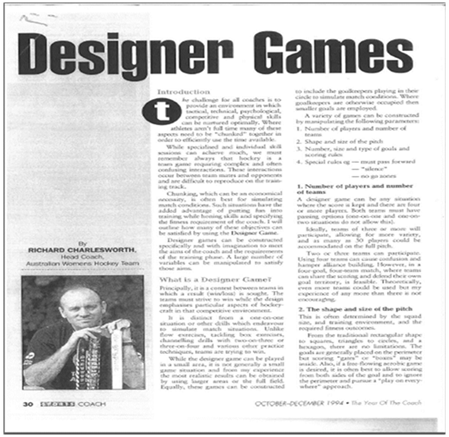
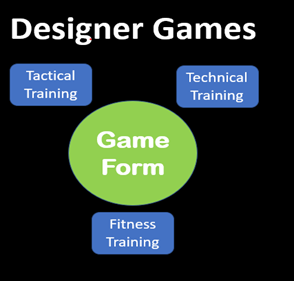
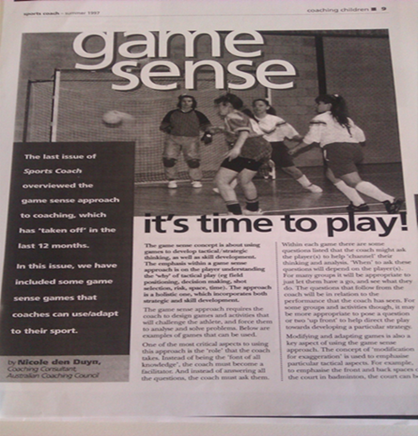
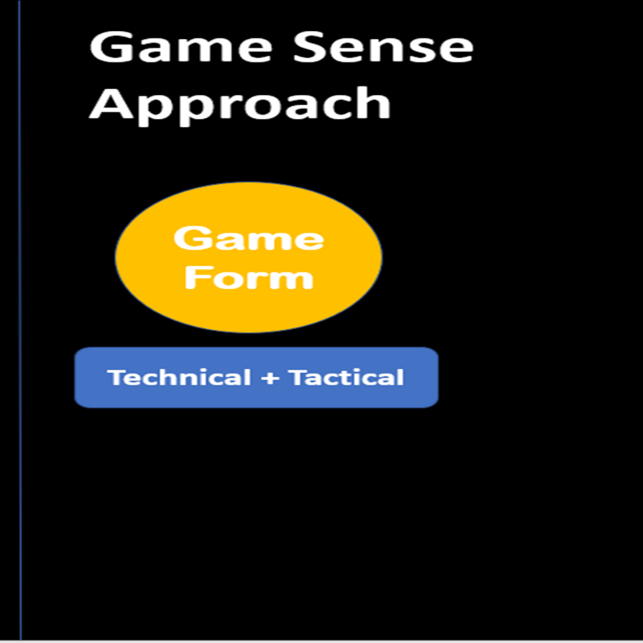
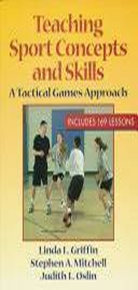
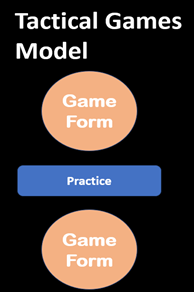
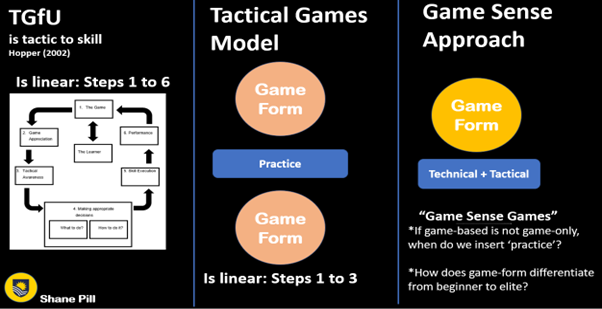
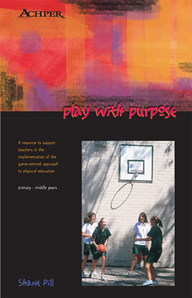
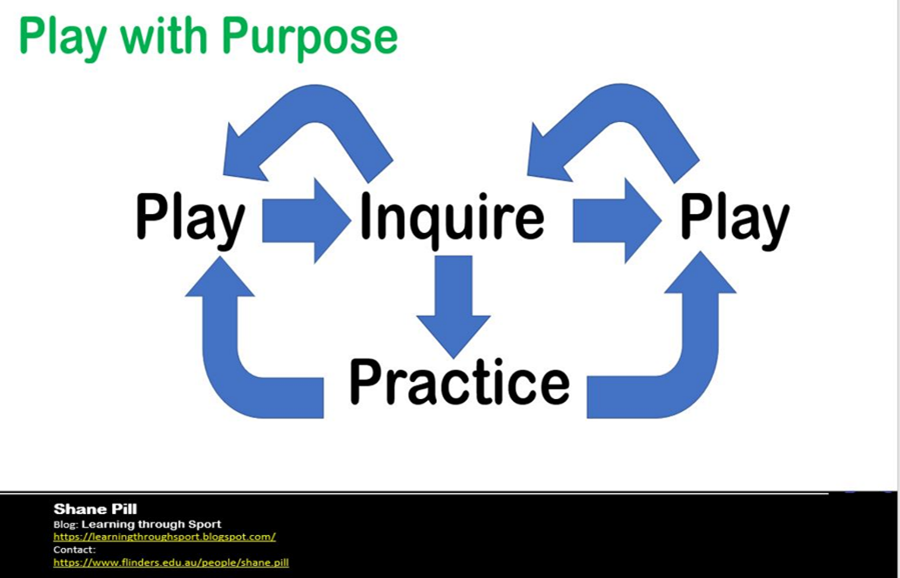
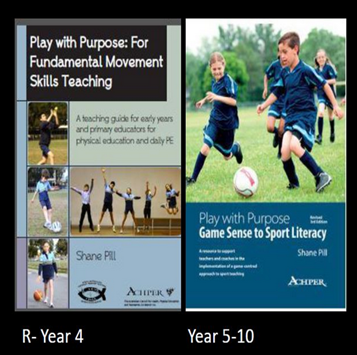
 RSS Feed
RSS Feed
